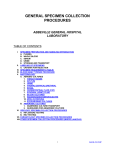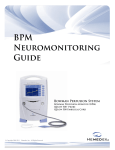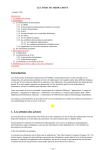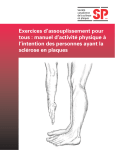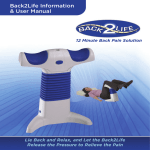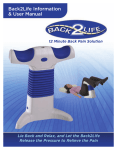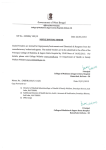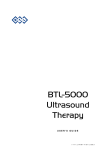Download Spasticity, Mobility Problems and Multiple Sclerosis
Transcript
Spasticity, Mobility Problems and Multiple Sclerosis The Multiple Sclerosis Society of Canada is proud to be a source of information about multiple sclerosis. Our comments are based on professional advice, published experience and expert opinion, but do not represent individual therapeutic recommendations or prescriptions. For specific information and advice, consult your physician. The MS Society of Canada publishes many other pamphlets and articles about various aspects of MS. Visit mssociety.ca/qc to consult or download them. MS Society of Canada, Quebec Division ISBN: 2-921910-26-8 Legal deposit – 3rd quarter 2011 Bibliothèque et Archives nationales du Québec Library and Archives Canada Spasticity, Mobility Problems and Multiple Sclerosis Table of content Introduction 3 Spasticity What is spasticity? How common is spasticity? 4 5 Treatment The treatment partnership 6 Self-help 7 Effective self-help means7 Treatment goals 8 Contractures8 Pressure sores 8 Rehabilitation9 Physical therapy 9 Orthotic devices 10 Occupational therapy 11 Here is a small sample11 Medications12 Drug therapy 12 A Final Option 16 Severe spasticity 16 Can people with MS improve their walking? 16 Two daily stretches for heel cords according to George Kaft, MD17 Help yourself 20 Conclusion 21 INTRODUCTION 3 Spasticity is one of the most challenging of all MS symptoms. It comes and goes. It feels different to different people, even to the same person at different times. There are occasions when a health care practitioner finds spasticity, but the person affected has no symptoms. Note, however, that muscle stiffness in MS (spasticity), although often detrimental, can enhance mobility and facilitate some types of movement. Spasticity is probably attributable to the central nervous system’s attempt to compensate for muscle weakness. This increase in muscle tone, called hypertonia, allows patients with partial paralysis (paraparesis) in their legs to perform transfers by pivoting and even to take a few steps with a walker. Spasticity becomes detrimental when it is out of proportion with the degree of muscle weakness. Spasticity is almost always undesirable when the legs are seriously or totally paralyzed (paraplegia). It is therefore important to deal with this symptom in order to maximize mobility and quality of life for the people affected. Spasticity What is spasticity? The word spasticity refers to involuntary muscle stiffness or spasms (sudden muscle contractions). In any coordinated movement, some muscles relax while others contract. Spasticity occurs when this coordination is impaired and too many muscles contract at the same time. MS-related spasticity can occur with active movement or be present at rest. It can cause a leg to lock up and refuse to bend. Spasms may be spontaneous or may be triggered by sudden pain, infection, or the beginning of voluntary movement. Spasticity, though not completely understood, is thought to be caused by increased sensitivity in the parts of muscles responsible for tightening, relaxing and stretching. This likely occurs as a result of demyelination of the nerves connected to these muscles, leading to excessive firing of the nerves that control the muscles. In mild cases, the condition is noticeable only as a feeling of tight or stiff muscles. When the condition is severe, the person can experience painful spasms or twisted limbs, which can impede mobility and other physical functions. There are two types of MS-related spasms: flexor and extensor. Flexor spasticity is defined as an involuntary bending of the hips or knees (mostly involving the hamstring muscles on the back of the upper leg). The hips and knees bend up toward the chest. Extensor spasticity is an involuntary straightening of the legs. Extensor spasticity involves the quadriceps (muscles on the front of the upper leg) and the adductors (inner thigh muscles), and the trunk. The hips and knees remain straight with the legs very close together or crossed over at the ankles. 5 How common is spasticity? Spasticity is one of the more common symptoms of MS. If all degrees of spasticity are taken together, it occurs in an estimated 80 percent of people with the disease. The question of degree is important. For one person, spasticity may cause a stiff leg, while in another, it makes walking impossible. For many people, the extra effort needed to move around when muscles are spastic contributes significantly to fatigue. On the other hand, spasticity can also compensate for muscle weakness, making it easier to stand, walk and move. Spasticity may also occur in the arms. Although this is less common in MS, upper limb spasticity can significantly interfere with important activities such as bathing, eating, handwriting and typing. Treatment The treatment partnership Because the condition is so individual, successful treatment of spasticity demands a true partnership between you and your doctor, nurse, physical therapist and occupational therapist. Your family also plays an important role. The first step in building a good treatment partnership is learning about the range of available treatment strategies. “Treating spasticity is not a matter of the doctor writing out a prescription for pills and saying come back in three months,” said Charles R. Smith, MD, Director of the MS program, Scripps Clinic, La Jolla, CA. The presence and degree of spasticity can be determined by your health care practitioner. He or she will stretch your legs to check for involuntary resistance. For example, if your leg is spastic, your muscles will automatically resist when it is moved quickly. If spasticity is mild, there will be minimal resistance; if the spasticity is severe, your leg may be so stiff that it cannot be bent at all. Treatment begins with your physician recommending ways to relieve the symptoms. Strategies may include medication, exercise, or changes in daily activities. To individualize the plan and to adjust the dosage of any medication to its most effective level, your doctor will need to follow your progress. He or she may also make referrals to other health care professionals, such as a physiatrist, physical therapist (PT) or occupational therapist (OT). Nurses, who are normally responsible for health education and for learning in detail how patients’ daily lives are affected by their symptoms, are an important part of this process. Take the time to ask your nurse questions and provide personal information. Both your doctor and nurse will guide you through the sometimes tricky process of adjusting medication. In addition, the PT and OT can provide individualized training with specific exercises and ways to make daily activities easier. 7 Self-help Spasticity, like other aspects of your MS, is unique to you. As with other MS symptoms, spasticity tends to come and go and to be worse under certain conditions. Typical triggers include cold temperatures, high humidity, tight clothing, tight shoes, pain, constipation and poor posture, having a viral infection such as a cold or the flu, or a bacterial infection including skin sores or bladder infections. In time, you will become aware of the triggers that affect you most. Some, like tight shoes, can be avoided. Other triggers warrant a doctor’s intervention. Effective self-help means •Don’t assume that nothing can be done! Spasticity does not have to be tolerated and improvement is usually possible. •Make sure that an appropriate exercise program is a regular part of your routine. The MS Society of Canada’s illustrated booklet, Everybody Stretch: A Physical Activity Workbook for People with Multiple Sclerosis could be useful. Ask your physical therapist, nurse or doctor for recommendations to meet your individual needs. •Explore complementary relaxation techniques such as progressive muscle relaxation, yoga, meditation or deep-breathing exercises. None of these is a cure, but they can make it easier to sleep at night and face the next day’s problems with a clearer head and reduced spasticity. •If your doctor agrees, explore massage. Massage can help relax muscles and enhance range of motion and may be helpful in preventing pressure sores. Massage should not be used if pressure sores or reddened areas of skin are present. 8 •Be patient but persistent through adjustments in daily activities; the types and doses of medication; the type and timing of exercise; and the use of devices, gadgets and adaptations. Treatment goals Spasticity interferes with daily activities, so the primary goal of treatment is to reduce the negative effects as much as possible. Sections of this booklet detail what can be accomplished by medication, physical therapy, orthotic devices (splints or braces) and occupational therapy. Some strategies seek to relieve the affected muscles; others involve learning to work around spasticity by adopting new ways of doing things. Treatment also aims to prevent the serious complications of spasticity. These include contractures (frozen or immobilized joints) and pressure sores. Since these complications also act as spasticity triggers, they can set off a dangerous escalation of symptoms. Surgical measures are considered for those rare cases of spasticity that defy all other treatments. contractures Contractures are not only painful and disabling, but can become permanent if left untreated, resulting in legs that can never be straightened and limited joint mobility in such places as the shoulder. Treatment (and prevention) of contractures usually combines treatment of spasticity with medication and physical therapy. Pressure Sores Pressure sores, sometimes called bedsores or pressure ulcers, occur in people who spend much of their day sitting or lying down. The term “bedsore” is misleading. One does not need 9 to be in bed all the time to be at risk for a pressure sore. MS reduces the thousands of small movements people ordinarily make both in sleep and while sitting down. MS can dull sensation in the buttocks or legs, eliminating the usual sensory cues to change one’s position. Spasticity contributes to pressure sores by making normal movement more difficult and by causing posture changes that create pressure points. Another cause of pressure sores is “shearing,” which occurs when the person is receiving positioning assistance from someone, and the movement is more sliding or dragging than lifting. Pressure sores begin innocently enough, as small reddened areas. The spot may not even feel painful or tender. However, there may already be significant damage to the soft tissues underneath reddened areas of skin. If pressure on the area is not relieved, the skin will break down, forming a sore. These sores can deepen quickly. They are prone to infection, and they can eventually destroy large areas of underlying tissue and even bone. Your health care practitioner can provide instruction in prevention and early detection. Dealing with spasticity is a good way to prevent pressure sores. The complications of infected pressure sores are sometimes severe and can even be fatal if the sores are not treated. Rehabilitation Physical therapy A physical therapist (PT) recommends and teaches specific exercises and movements that can increase flexibility and relieve spasticity. First, you will have several tests that measure muscle tone, resistance, strength and coordination. You’ll also be asked about your general functioning in routine daily activities. In addition to stretching exercises you do yourself, PTs also relieve spasticity with specific exercises (done with the help 10 of another person) to stretch and relax shortened muscle fibres, increase joint movement, extend contracted muscles and improve circulation. Some of these techniques may be taught to a family member or helper so that they can be performed on a routine basis at home. Physical therapy can also help maintain range of motion to prevent contractures. Strengthening exercises prescribed by the PT are important because a muscle that is spastic is not necessarily strong. And strengthening the spastic muscles, as well as the muscles that oppose the spastic ones, may be particularly beneficial. This is like making sure that both the “push” and the “pull” of the muscles are in good condition. Hydrotherapy (therapy using water) may also be recommended, as well as local application of cold packs. Hydrotherapy is a very effective way to temporarily relax spastic limbs, especially when used in combination with gentle stretching. For those who are unable to stand independently, a standing frame allows for stretching of leg muscles, as well as pressure on the leg bones, which helps limit bone mineral loss (osteoporosis). Orthotic devices Orthotic devices (such as braces and splints) maintain the leg in a more normal position, which makes it easier to move around or get into a more comfortable position. These devices should be fitted by a professional. A common example is the ankle-foot orthosis (AFO), which places the ankle in a better alignment. Although many drugstores and catalogues offer them over-the-counter, ill-fitting devices can aggravate spasticity and cause pressure sores or pain. Therapists can direct you to the best options and teach you how to use orthotics. 11 Occupational therapy Occupational therapists (OTs) are experts in modifications that make daily life with spasticity more comfortable and enhance independence. Individualized training can be very helpful in making daily activities such as dressing and showering easier and more energy efficient. Home modifications might include replacing small drawer pulls with large knobs, spraying drawer tracks with silicone to make the drawers glide, or lowering the clothes bar in your closets. OTs will recommend assistive devices and will often have samples you can try in order to determine what works best. You may be amazed at the ingenuity of the available devices. Here is a small sample: •Dressing aids: These include stocking aids, long-handled shoehorns, and shoe/boot removers, which allow you to dress with a minimum of bending if you are experiencing stiffness in your trunk or legs; elastic shoelaces that let you slip in and out of shoes without having to retie them; zipper pulls, and more. •Toiletry and grooming aids: In addition to electric shavers and electric toothbrushes, there are easy-grip handles for shaving-cream cans, combs or brushes, long-handled brushes for washing your feet, and other tools to help you extend your reach while bathing. •For people who use wheelchairs, OTs may also recommend positioning changes that minimize spasticity. Sometimes simple adjustments in the height of a footrest or the width of a seat along with an appropriate seat cushion can make a world of difference. •OTs can also develop exercise programs for your hands and arms, and may recommend splints that position the hands to enhance function and preserve joint mobility. 12 Medications Drug therapy There are a few medications approved for the treatment of spasticity, and other medications that can serve well in certain situations. The most effective dosage will depend on striking a balance between the drug’s good and bad effects. An effective dosage tends to vary from time to time. An infection, cold weather, an ingrown toenail – whatever triggers your spasticity – will also influence the amount of medication needed to manage the muscle stiffness. Typically, the doctor will increase the dose of medication gradually until the full benefit is evident, and reduce the dose if side effects occur. In addition, people on your health care team can suggest timing your medication in specific situations. For example, taking an antispasticity medication an hour before sexual activity can prevent painful spasms during orgasm. Baclofen Baclofene (Lioresal®) is a muscle relaxant that works on the spinal cord and relaxes normal and spastic muscles. It is most often taken three or four times a day, and common side effects are drowsiness and muscle weakness. Nausea, a less common side effect, can usually be avoided by taking baclofen with food. The drug has a good safety record with long-term use. The side effects do not build up or become worse over time. At high doses, this medication reduces concentration and contributes to fatigue. Because it usually restores flexibility within a short period, baclofen may make other treatments, such as physical therapy, more effective. Baclofen does not cure spasticity or improve coordination or strength. A gradual increase in dosage often allows for higher and more effective doses to be taken. Baclofen should not be greatly reduced or stopped suddenly without consulting your physician because seizures and other problems can result. 13 “Intrathecal” baclofen Some people require a higher dose of baclofen but cannot tolerate the increased side effects. A surgically implanted pump can deliver very small amounts of the drug directly into the fluid that surrounds the spinal cord. The baclofen pump has been extremely successful. The pump can improve (or at least maintain) a person’s level of functioning and may even help some people remain ambulatory. Furthermore, the pump permits people with very limited mobility to be positioned to minimize pain and the risk of pressure sores. The computer-controlled, battery-operated pump, which weighs about six ounces, is surgically implanted under the skin of the abdomen. A tube runs from the pump to the spinal cord. The pump is programmed to release a pre-set dose specific to the individual. People who use the pump see their physician or nurse for a new drug supply and a check of the computer program every one to three months. The new drug supply is injected into the pump through the skin. The little computer can be reprogrammed painlessly by radio signals. When the battery wears out (in five to seven years) the pump itself is surgically removed and replaced. The tube remains in place. Tizanidine Tizanidine (Zanaflex®) works quickly to calm spasms and relax tightened muscles, but may cause greater sedation than other medications. Tizanidine is typically taken three times a day. In addition to drowsiness, dry mouth is a common and usually temporary side effect. Hypotension (low blood pressure) is another potential, but less frequent, side effect. This drug also has a good safety record with long-term use. It does not cure spasticity or improve muscle coordination or strength. A combination of baclofen and tizanidine may give the best results. Tizanidine should be taken with caution with 14 ciprofloxacin HCI (Cipro®), which is used to prevent or treat urinary tract infections, since increased drowsiness or sleepiness can occur. Diazepam In small doses, diazepam (Valium®) may also be used in spasticity treatment. This drug is not as effective as those mentioned above, but it has the benefit of relieving anxiety, which makes it easier for someone who is restless or has disturbing night-time spasms to relax and get a good night’s sleep. Drowsiness and potential dependency with long-term use make diazepam a less desirable choice. However, in some circumstances, diazepam and another antispasticity drug may be prescribed together. People for whom this works say that they would rather be a bit sluggish and fully flexible than wide awake and spastic. Clonazepam (Klonopin®), a similar medication, can also help control spasms, particularly at night. Gabapentin Gabapentin (Neurontin®) is used to control some types of seizures in epilepsy. In MS, gabapentin controls certain types of pain and can reduce spasticity. The most common side effects include blurred or double vision, dizziness and drowsiness. Once you have started on it, gabapentin should not be stopped without consulting your physician. Dantrolene Dantrolene sodium (Dantrium®) is generally used only if other drugs (alone or in combination) have been ineffective. It works by partially paralyzing muscles, making it a poor choice for people who walk. Dantrolene can produce serious side effects, including liver damage and blood abnormalities. The longer a person takes this drug, the more these problems are likely to develop. People taking dantrolene must have periodic blood tests. 15 Levetiracetam Levetiracetam (Keppra®) is another drug used for seizure control in some forms of epilepsy. In MS, it can sometimes be helpful in improving spasticity and spasms. Side effects and treatment considerations are similar to those seen with gabapentin. Botulinum toxin Injection of botulinum toxin (Botox®) has been shown to help spasticity. However, the benefit is limited to the injected muscles, and the treatment must be repeated every three to six months. Only small amounts of the drug can be injected into the body at any one time; otherwise, the immune system might create antibodies against it. For these reasons, Botox may not be a good choice when many muscles are spastic or the spastic muscles are large. However, Botox injections are a very good choice when one or two muscles of the arm are spastic, as these muscles are small and do not require a lot of medication. Side effects include weakness of the injected muscle and some nearby muscles, and a brief “flu-like” syndrome. Health Canada has approved the use of botulinum toxin for treatment of focal spasticity that is characterized by muscle stiffness and contractions that limit movement in part of the body. Phenol Another treatment is the injection of a nerve block called phenol. This treatment also needs to be repeated every three to six months, and is often effective when oral agents have had unsatisfactory results. 16 A Final Option Severe spasticity Enormous progress has been made in controlling spasticity in the past two decades. If none of the treatments discussed above have helped, surgery might be recommended for relief. The relief is permanent, but so is the resulting disability. The techniques include severing tendons (tenotomy) or nerve roots (rhizotomy) in order to relax cramped-up muscles. These measures are only undertaken after serious consideration and for the most difficult cases of spasticity. Can people with MS improve their walking? There are ways to improve mobility, especially after a relapse. Your neurologist will tell you if an exercise program developed by a physiotherapist may help you. Muscle stretching is still the basic treatment for spasticity, even in advanced stages where the purpose is mainly to prevent contractures. In January 2010, The U.S. Food and Drug Administration (FDA) approved the marketing of AmpyraTM (dalfampridine) because of its ability to increase walking speed in 35% of people with any type of multiple sclerosis. Studies have shown benefits for people whose disability is as high as 7 on the Kurtze Expanded Disability Status Scale (EDSS). The United States was the first country to approve Ampyra (also known as Fampyra in some countries). At the time this brochure was printed, dalfampridine/fampridine was not approved in Canada. 17 Two daily stretches for heel cords according to George Kaft, MD Stretching the Achilles tendon, or heel cord, is something almost everyone with MS should do every day. The key to both exercises is to keep the active leg straight and to hold the stretch for five minutes. Sit on your bed or a steady chair with your back straight. Let one leg hang down. Put a towel around the bottom of your active foot, lift the leg, and pull on the towel with both hands. You should feel a strong stretch but not pain. Hold for five minutes. Repeat on the other side. When new patients come to see me, they never say, “Please fix my T-cells.” They tell me they’re tripping and falling and ask if anything can be done. The answer is yes. I first need to find out what the problem is: Is it weakness, spasticity (muscle tightness), ataxia (loss of balance), fatigue, impairment of proprioception (the inability to identify where the foot is in space), or a combination? Is it in one limb or in both? Many people (and some therapists) immediately think “brace” when they see leg weakness. But that may not be the best choice. A person may actually have adequate strength, but spasticity in the ankle region is getting in the way. Tightness related to spasticity can prevent the person from bringing the toes up high enough for a smooth step forward. A form of MS fatigue may also be involved. The person’s legs are sufficiently strong but become fatigued after a few 18 minutes of walking. This muscle fatigue, which is related to altered nerve conduction, may be severe enough to cause tripping or falling. Spasticity can usually be controlled with medication, with careful attention to dosage. Too much medication reduces spasticity but makes the limbs floppy; too little and the limb is painfully tight. Also, the dose may need to be adjusted temporarily due to factors such as cold weather or infection. Since spasticity can also change from time to time, the person should be evaluated periodically, and the dose adjusted accordingly. If impaired balance is involved, the person will need his or her base of support broadened by the use of a cane or a walker. Many physical therapists have learned about techniques for improving walking primarily through work with patients who have had a stroke; but stroke is a fixed condition, unlike MS, which tends to progress. Those whose training is in sports medicine tend to focus on restoring strength and may not see the other MS-related components. Here’s how I usually start. Instead of prescribing braces, I advise wearing shoes that have a slippery toe section. I adjust the antispasticity medication and teach the patient to stretch the heel cord. Spasticity and lack of use can make the cord so tight that the heel does not go down or the toes up. Regular stretching actually remolds the muscle. Weak muscles can be strengthened despite MS muscle fatigue. I recommend focused weight training, because results can be obtained with relatively low general effort. Lifting a leg 10 times with a weight on the large toe will 19 have a positive effect—but you won’t break a sweat doing it. I select one or two muscles to strengthen, which can be done with five minutes of daily work. I will prescribe a brace if strengthening measures aren’t enough. Today’s braces are unobtrusive, lightweight plastic. The heel cord stretch is important here, too, because a person has to get the heel down into the brace. A cane, used properly, is superb for broadening a person’s base of support. Canes are simple. There are hundreds of attractive choices, and people generally find them quite acceptable. If they still have a hard time with balance, we need to try a walker. Again, there are walkers in many designs and colors, and they help people walk safely. Finally, if a walker isn’t enough, I talk about the ways in which a wheelchair can enable a person to be more mobile. The adjustment may not be easy, but the goal is mobility. A wheelchair is not a prison. It gets you where you want to go. People with MS tend to use different devices at different times—and sometimes they need nothing at all. Family, friends, and employers need to learn how variable MS can be. 20 Help yourself •Take a look at your shoes. The scuffing patterns show if the toe is not coming up high enough. The patterns also show which leg is weaker. •Sneaker soles catch and stick on almost anything. But everyone loves them. Have a shoemaker put low-friction toe caps on your sneakers and on your dress shoes, too. •Keep notes about your walking problems. When do you trip? All the time? After walking 10 or more minutes? While shopping or talking, when you aren’t concentrating on your gait? •Test your stretch. Sit on a chair. Can you raise your leg straight out? When you do, does your foot come up above neutral, or do your toes point down? •Tell your physical therapist about everything you learn from this. If the therapist immediately suggests a brace, ask to try working on function first. CONCLUSION A treatment plan for spasticity and mobility problems requires close cooperation of caregivers and the person with MS. Medical follow-up can help people deal with these symptoms better to maximize their quality of life. Sources This publication has been adapted and reprinted by the Quebec Division, Multiple Sclerosis Society of Canada with permission of the National MS Society (USA). This brochure was reviewed by Dr. François Grand’maison, MD FRCP (C) 4 This publication was produced thanks to an inconditional grant from: Contact us 550 Sherbrooke Street West, East Tower, Suite 1010 Montreal (Quebec) H3A 1B9 514-849-7591 or 1-800-268-7582 [email protected] mssociety.ca/qc Follow us Facebook Twitter (Toll Free in Quebec)

























